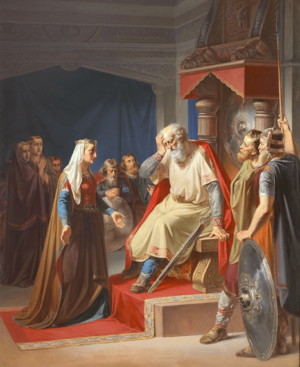Gorm the Old facts for kids
Quick facts for kids Gorm the Old |
|
|---|---|

Gorm learns of the death of his son Canute, painting by August Carl Vilhelm Thomsen
|
|
| King of Denmark | |
| Reign | c. 936 – 958/963/964 |
| Predecessor | Harthacnut (Canute I) (semi-legendary) or Gnupa |
| Successor | Harald I |
| Born | before 900 |
| Died | 958/963/964 |
| Spouse | Thyra |
| Issue Detail |
|
| House | House of Gorm |
| Father | Harthacnut I of Denmark (semi-legendary) |
| Mother | unknown |
| Religion | Norse paganism |
Gorm the Old (also known as Gorm the Languid) was a famous king of Denmark. He ruled from around 936 until his death, which happened sometime between 958 and 964.
Gorm ruled from a place called Jelling. He is known for creating the oldest of the famous Jelling stones to honor his wife, Thyra. Gorm was born before the year 900.
Contents
Becoming King of Denmark
Gorm the Old was the son of Harthacnut, a Danish king whose story is part legend and part history. A writer named Adam of Bremen said that Harthacnut came to Denmark and took power in the early 900s. When Harthacnut died, Gorm became the new king.
Some old stories say that Gorm had to fight to take control of parts of the kingdom. He is first mentioned in history in 936. At that time, he met with a religious leader named Archbishop Unni.
The famous Jelling Stones tell us that Gorm's son, Harald Bluetooth, later "won all of Denmark." This makes some people think that Gorm might have only ruled over a part of Denmark called Jutland, from his home in Jelling.
Gorm's Family Life
Gorm married a woman named Thyra. We don't know much about her parents. Gorm built one of the large burial mounds at Jelling for her. He also made the oldest Jelling Stones in her honor. On the stone, he called her "Denmark's Salvation" or "Denmark's Adornment."
Gorm and Thyra had three sons: Toke, Knut, and Harald. Harald later became the famous King Harald Bluetooth.
Thyra, Gorm's wife, is also known for helping to finish the Danevirke. This was a very long wall built to protect Denmark from its neighbors to the south, the Saxons. The wall wasn't new, but it was made stronger with a ditch and a wooden fence on top. The Danevirke stretched across what is now Schleswig.
The Death of King Gorm
One idea is that Gorm died in the winter of 958–959. This is based on studies of wood from his burial chamber. The wood was cut in 958.
There is a famous story about Gorm's death. It says that his three sons were Vikings who often went on raids. One day, Harald came back to Jelling with sad news: his brother Canute had been killed while trying to capture Dublin, Ireland. Canute was shot with an arrow during some games.
No one wanted to tell King Gorm because he had made an oath. So, Queen Thyra came up with a clever plan. She ordered the royal hall to be decorated with black cloth. When Gorm entered, he was surprised and asked what the mourning colors meant.
Queen Thyra then told him a story: "Lord King, you had two falcons, one white and one gray. The white one flew far away and was attacked by other birds. It lost its beautiful feathers and is now useless. But the gray falcon still catches food for your table."
Gorm immediately understood her message. He cried out, "My son is surely dead, since all of Denmark mourns!" Thyra replied, "You have said it, your majesty. Not I, but what you have said is true." The story says that Gorm was so sad about Canute's death that he died the very next day.
However, this story might not be completely true. The Jelling Stones suggest that Queen Thyra died before Gorm.
Gorm's Burial Place
Some experts believe that Gorm was first buried in Queen Thyra's grave mound at Jelling. Later, his son, Harald Bluetooth, moved his body to the first wooden church in Jelling. It is thought that the skeleton found at the site of this early Christian church might actually be Gorm the Old. However, this idea is still being discussed by historians.
During Gorm's time, most Danes worshipped the old Norse gods. But during the rule of Gorm's son, Harald Bluetooth, Denmark officially became Christian. Harald left the hill where Gorm was first buried as a special memorial.
Gorm's Importance Today
Gorm was called "the Old" because he was seen as the traditional founder and leader of the Danish kings. A writer named Saxo Grammaticus said that Gorm lived a very long time. He even said that Gorm was blind by the time his son Canute was killed.
See also
- Gorm's Cup

